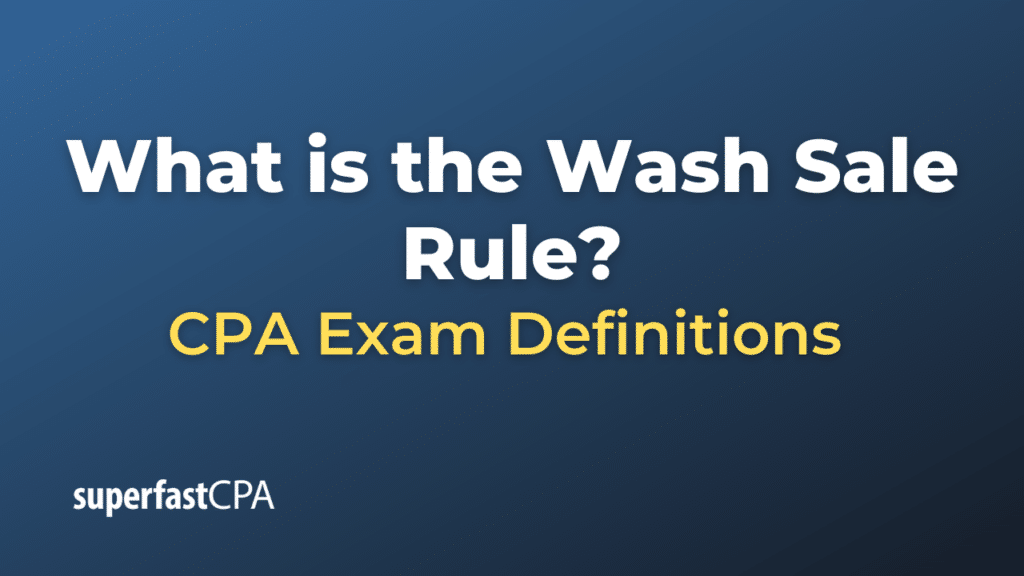Wash Sale Rule
The Wash Sale Rule is a regulation set forth by the Internal Revenue Service (IRS) in the United States to prevent taxpayers from claiming artificial losses for the purpose of reducing their taxable income. This rule applies to both stocks and securities. According to the Wash Sale Rule, if an investor sells a security at a loss and then buys a “substantially identical” security within a 61-day period, which encompasses 30 days before and 30 days after the sale date, the loss from the sale is typically disallowed for tax purposes.
How It Works:
Imagine you own 100 shares of Company X, and you’ve seen a significant drop in value since you purchased them. If you sell those shares to realize the loss and then buy the same or substantially identical shares within 30 days before or after the sale, the IRS would disallow the loss for tax deduction purposes under the Wash Sale Rule. The disallowed loss is then usually added to the cost basis of the new shares acquired.
Accounting for Wash Sales:
Let’s say you bought 100 shares of Company X at $50 each (total cost = $5,000). The value of these shares drops to $40 each, and you sell all 100 shares to realize a loss of $1,000.
- If you buy 100 shares of Company X again within 30 days at $45 per share, the $1,000 loss would be disallowed under the Wash Sale Rule.
- The $1,000 disallowed loss would then be added to the cost basis of your new shares, making it $4,500 (100 shares x $45) + $1,000 = $5,500.
Purpose:
The Wash Sale Rule is designed to discourage investors from selling securities at a loss simply to claim a tax benefit. A tax benefit would allow the investor to offset gains or income and thereby pay less tax, only to immediately buy back the same or a substantially identical security.
Exceptions and Complexities:
- The rule applies to not only the same stock but also “substantially identical” securities, which can include different shares of the same or a very similar company, or even options to buy shares.
- The rule applies across accounts, including tax-advantaged accounts like IRAs.
- The rule doesn’t only apply to individual investors; it also applies to businesses, trusts, and any other taxpayer.
Understanding the Wash Sale Rule is crucial for investors to properly manage their investment portfolios in a tax-efficient manner. Failure to comply could result in the disallowance of potentially significant tax deductions. Always consider consulting with a tax advisor for personalized advice.
Example of the Wash Sale Rule
Let’s use an example to illustrate how the Wash Sale Rule works.
Background:
- Investor Alice owns 100 shares of Company Z, which she bought at $50 per share.
- The total cost basis of her investment is 100 shares x $50 = $5,000.
Scenario:
- Initial Sale: On January 1, Alice sells all 100 shares of Company Z at $40 per share because the stock has been performing poorly. She incurs a loss of ($50 – $40) x 100 = $1,000.
- Potential Tax Benefit: Alice hopes to use this $1,000 loss to offset other capital gains or income for tax purposes.
- Repurchase: On January 15, Alice feels that Company Z will rebound and decides to buy back 100 shares at $45 per share.
Impact of the Wash Sale Rule:
Because Alice bought “substantially identical” shares within 30 days of her original sale, the Wash Sale Rule is triggered.
- Disallowed Loss: The $1,000 loss she initially realized becomes disallowed for tax purposes.
- Adjustment to Cost Basis: The disallowed loss is added to the cost basis of her new shares.
- New cost basis = (100 shares x $45) + $1,000 disallowed loss
- New cost basis = $4,500 + $1,000
- New cost basis = $5,500
Future Implications:
- Tax Reporting: Alice cannot claim the $1,000 loss on her current year’s tax return. Instead, the loss is incorporated into the cost basis of her new shares.
- Future Sale: If Alice sells her shares again in the future, the higher cost basis will affect her reported gain or loss at that time.
- For instance, if she sells these new shares at $60 each in the future, her capital gain for tax purposes would be calculated as follows:
- Selling price: 100 shares x $60 = $6,000
- Cost basis: $5,500
- Capital Gain: $6,000 – $5,500 = $500 (instead of $1,000 if the original loss had been allowed)
- For instance, if she sells these new shares at $60 each in the future, her capital gain for tax purposes would be calculated as follows:
By understanding the implications of the Wash Sale Rule, Alice can make more informed decisions about her investment strategy and its tax consequences. It’s also worth noting that these rules can be complicated, and it’s usually advisable to consult a tax advisor for personalized advice.













